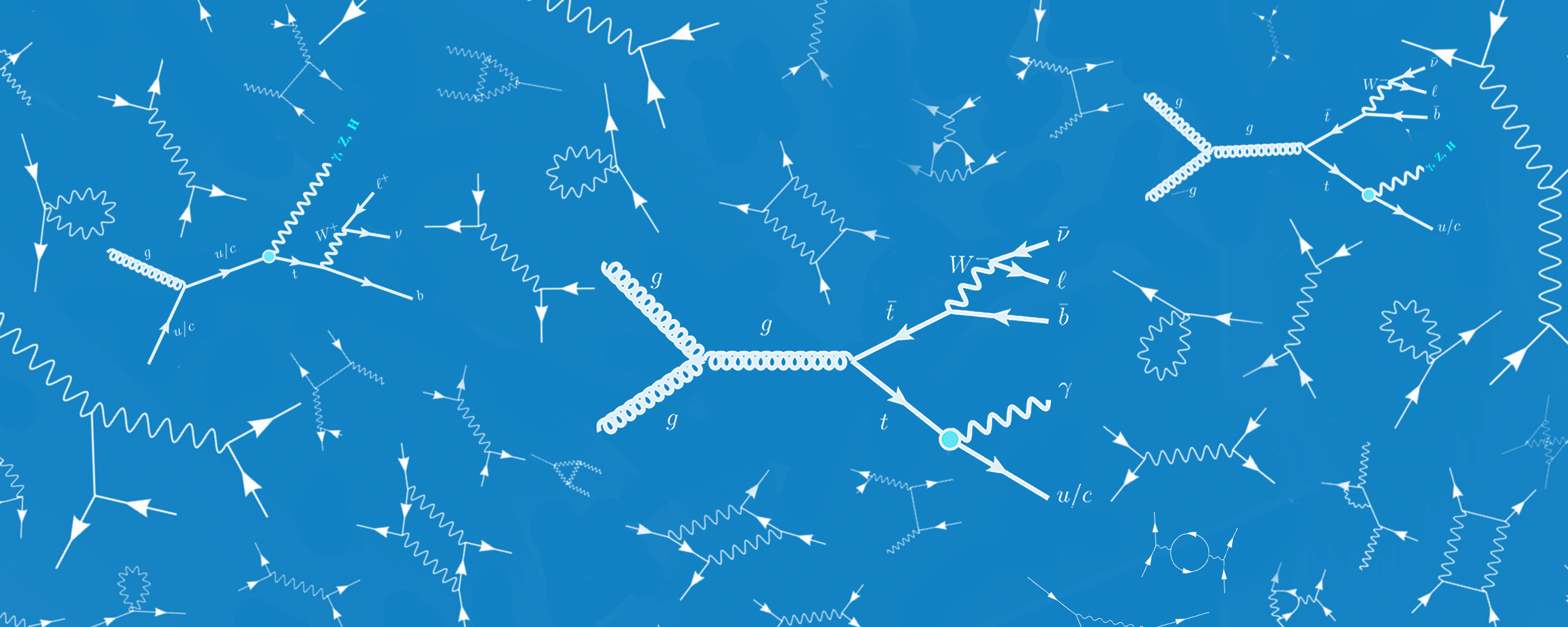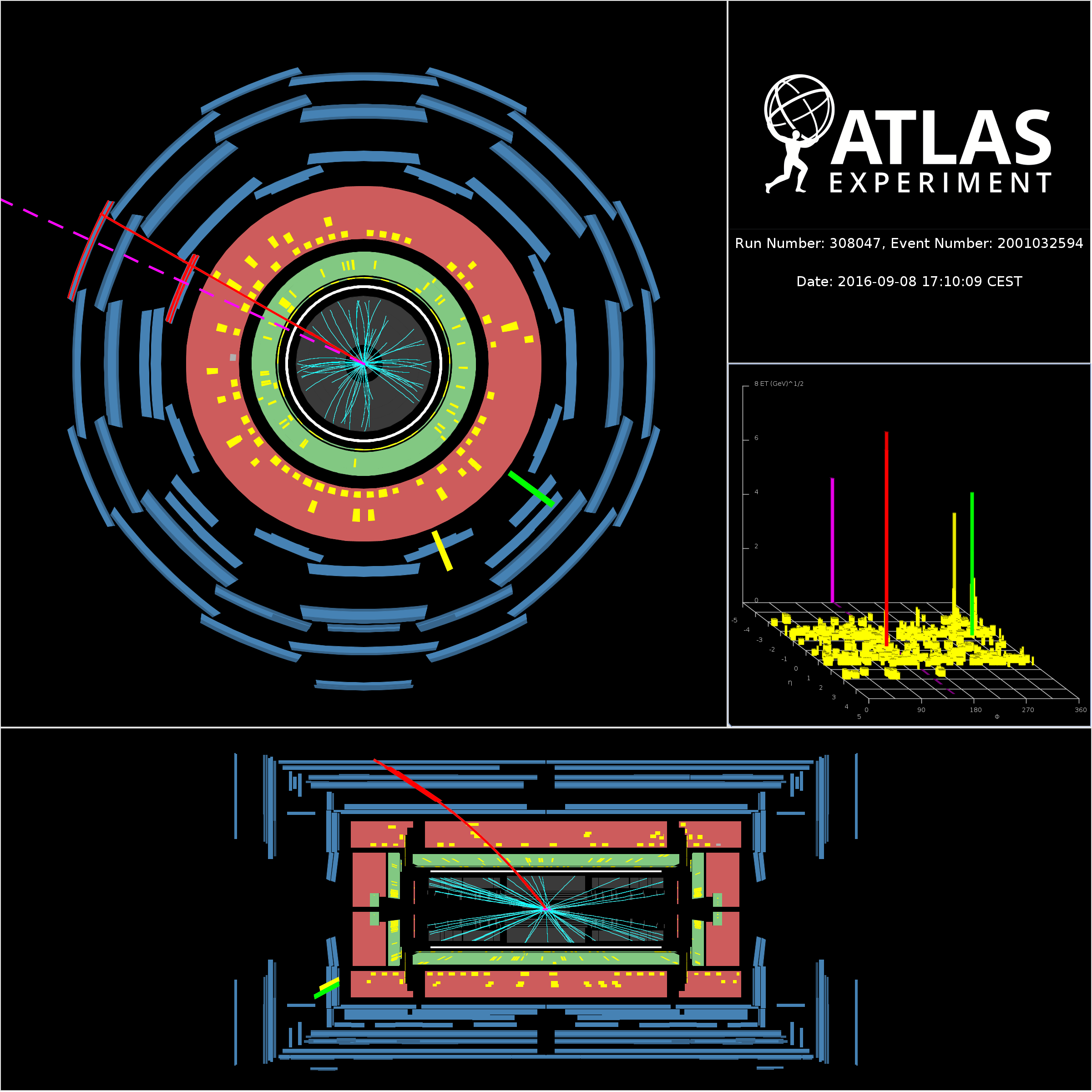ATLAS looks for top quarks going against the current
16 May 2022 | By
When looking for physics beyond the Standard Model, no single line of investigation is enough! In addition to direct searches for new particles, the ATLAS Collaboration has a wide research programme dedicated to finding non-standard interactions between Standard Model particles.
Among these are searches for flavour-changing neutral current (FCNC) processes in top-quark interactions. There are six different types – or flavours – of quarks. In the Standard Model, quarks can change flavours via the weak interaction. However, the top quark is expected to mainly transform into a W boson (a charged particle) and a bottom (b) quark. Should they be observed changing flavours via a neutral boson, it would be an unambiguous signal of physics beyond the Standard Model.
Using the full Run-2 dataset, the ATLAS Collaboration has published four analyses searching for FCNCs in the production and decay of the top quark. The results study top-quark processes involving all four neutral bosons: the photon, gluon, Z boson and Higgs boson.
ATLAS physicists are searching for evidence of flavour-changing neutral currents in top-quark interactions – these would be an unambiguous signal of physics beyond the Standard Model.
Shedding light with photon interactions
In their first analysis, ATLAS physicists searched for the FCNC process in two modes of top-quark interactions with photons: the production mode, where a single top quark is produced association with a photon via a FCNC interaction (q→tγ), and the decay mode, where a top quark decays via a FCNC interaction into an up or charm quark in association with a photon (t→uγ or t→cγ). This required the selected collision events to have one highly-energetic photon, one electron or muon, and at least one jet of particles originating from a b quark.
Researchers trained artificial neural networks using simulated events, allowing them to distinguish between FCNC production, FCNC decay and Standard Model processes. These three outputs were combined to form a discriminant to isolate possible new-physics contributions. When compared to observed data, physicists found no significant excess. Limits were set on the strength of these FCNC interactions and on the decay probabilities (branching ratios) for the FCNC top-quark decays (see Figure 1). These limits improve on previously published results by a factor of 3 to 5, depending on the FCNC interaction.

Seeking strong shifts in currents
The ATLAS Collaboration also investigated potential FCNC interactions between top quarks and gluons. In their second new analysis, physicists studied events in which an up or charm quark interacts with a gluon, producing a single top quark via an FCNC interaction (u+g→t or c+g→t). Physicists further narrowed their search by looking for top-quark decays into a b quark and a leptonically-decaying W boson – leaving an experimental signature with a b-quark jet, an electron or a muon with high transverse momentum, and missing transverse energy signalling the presence of a neutrino.

Physicists were thus able to exploit specific kinematic features of single-top-quark production to separate a potential signal from dominating Standard-Model background processes. They developed special calibration techniques for identifying b-quark jets, and trained artificial neural networks to several kinematic variables in order to separate a potential FCNC signal from background. No significant excess of events was found, and limits were instead set on the production cross section of single top quarks via FCNCs (see Figure 2). These cross-section limits were also considered in an “effective field theory”, yielding new limits on coefficients of the theory. Thus, researchers were also able to set limits on the branching ratios of corresponding FCNC top-quark decays. These bounds improve on ATLAS results obtained with Run-1 data by approximately a factor of two.
Changing hands with Z-boson processes
For their third investigation, ATLAS researchers focused on possible FCNC interactions between a Z boson and a top quark. Their analysis looked at events where a single top quark is produced via a FCNC interaction alongside a Z boson (gq→tZ), and top-quark-pair events where one top quark decays via a FCNC interaction into an up or charm quark, and a Z boson (t→uZ or t→cZ). Such processes would leave an experimental signature in ATLAS with three leptons (electrons or muons), a b-quark jet, possible additional jets and missing transverse momentum.
Researchers found the data to be consistent with the Standard Model and set limits on the branching ratios of single-top FCNC interactions. These are the most stringent limits on such processes to date and, for the first time, examine the likelihoods depending on the handedness of the interaction.
Hiding out with the Higgs?
ATLAS’ fourth and final analysis ventured into the Higgs realm, with researchers searching for FCNC interactions between a top quark and a Higgs boson. For their analysis, they targeted top-quark pair decays – where one top decays normally (t→Wb) and the other decays via a FCNC interaction into another quark and a Higgs boson (t→uH or t→cH) – and FCNCs in production where the top quark is produced alongside a Higgs boson (pp→tH).
Researchers further focussed their search on collision events with either two hadronically-decaying tau leptons, or one tau lepton alongside an additional light lepton (electron or muon), a b-quark jet and multiple additional jets. To distinguish signal events from background processes, physicists used multivariate techniques based on boosted decision trees to spot subtle differences in each event's kinematics.
They found a slight excess of data above the expected Standard Model background, with a significance of 2.3 sigma, and set limits on the branching ratio for top-quark decay via FCNC interactions (see Figure 3), as well as on the effective coupling constants for FCNC interactions between the top quark and the Higgs boson. These results significantly improve on previously published ATLAS studies.

Turning the tides in Run 3
With these searches of the full Run-2 dataset now complete, ATLAS researchers are turning their focus to the upcoming Run 3 of the LHC. While some searches for FCNC processes will be improved by a larger dataset, others require the development of new analysis techniques. For example, the sensitivity of the analysis looking for FCNC interactions between top quarks and gluons is limited by systematic uncertainties. Physicists are already exploring new approaches for improving the reach of this channel.
Learn more
- Search for flavour-changing neutral-current couplings between the top quark and the photon with the ATLAS detector at 13 TeV (arXiv: 2205.02537, see figures)
- Search for flavour-changing neutral-current interactions of a top quark and a gluon in proton-proton collisions at 13 TeV with the ATLAS detector (Eur. Phys. J C 82 (2022) 334, arXiv: 2112.01302, see figures)
- Search for flavour-changing neutral-current couplings between the top quark and the Z boson with LHC Run 2 proton-proton collisions at 13 TeV with the ATLAS detector (ATLAS-CONF-2021-049)
- Search for flavour-changing neutral current interactions of the top quark and the Higgs boson in events with a pair of τ-leptons in proton-proton collisions at 13 TeV with the ATLAS detector (ATLAS-CONF-2022-014)
- Search for flavour-changing neutral currents in processes with one top quark and a photon using 81 fb−1 of proton-proton collisions at 13 TeV with the ATLAS experiment (Phys. Lett. B 800 (2020) 135082, arXiv: 1908.08461, see figures)
- LHCP 2022 presentation by Marumi Kado: ATLAS Status and Overview
- See also the full lists of ATLAS Conference Notes and ATLAS Physics Papers.




